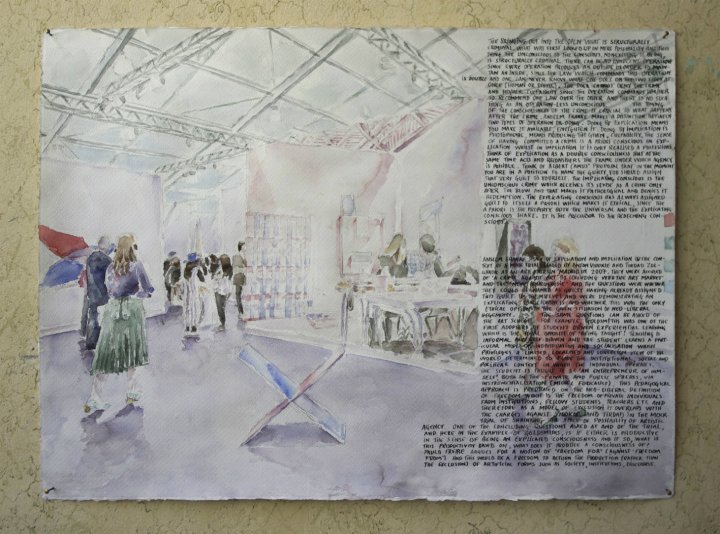
A Crime Against Art
Watercolour and ink on paper, 76 x 56cm, 2016
Text:
The bringing out into the open what is structurally criminal, what was first locked up in mere possibility and thus tying the unconscious to the conscious, non-existing to being, is structurally criminal. There can be no innocent operation since every operation produces an outside in order to maintain an inside, since the law which commands this operation is double and one can never know what one does on the two sides at once (human or divine). The doer cannot deny the crime, his/her culpability since the operation commands him/her to recommend one law over the other and there is no such thing as an operation-less unconscious. The timing of the consciousness of the crime is crucial to what happens after the crime. Anselm Franke makes a distinction between two types of operation or doing. Doing by explication means making it available, enlightening it. Doing by implication is photophobic, means producing the given. Culpability, the sense of having committed a crime is a priori conscious in explication whilst in implication it is only realised a posteriori. Think of explication as a double consciousness that at the same time acts and reconsiders the frame under which agency is possible. Think of Albert Camus’ proposal that in the moment you are in a position to name the guilty, you should assign that very guilt to yourself. The implicating conscious is the unconscious crime which receives its sense as a crime only after the blow and that makes it pathological and denies it redemption. The explicating conscious has always assigned guilt to itself a priori which makes it ethical, since the a priori is the property both the universal and the explicating conscious share. It is the precursor to the redeeming conscious.
Anselm Franke spoke of explication and implication in the context of a mock trial staged by Anton Vidokle and Tirdad Zolghadr at an art fair in Madrid in 2007. They were accused of ‘a crime against art’ by colluding with the art market and the ‘new bourgeoisie’ and the questions were whether they could be named as guilty having already assigned this guilt to themselves and were demonstrating an explicating consciousness and whether this was the only ethical option in the given situation of neo-liberal hegemony. The same questions can be asked of the art school. For example, Goldsmiths was one of the first adopters of student driven experiential learning which is the ideal opposite of ‘being taught’. Teaching is informal and self-driven and the student learns a particular mode of individuation and socialisation which privileges a limited, localised and sovereign view of the world determined to elide the institutional, social and political context in which the individual operates. The student is taught to be an ‘entrepreneur of himself’ (Michel Foucault), both in the private and public spheres, via self-instrumentalisation. This pedagogical approach is predicated on the neo-liberal definition of freedom which is the freedom of private individuals from institutions, fellow students, teachers etc. and therefore as a model of exclusion it overlaps with the charges against Vidokle and Tirdad in the mock trial of shrinking the space of possibility of artistic agency. One of the concluding questions asked at and of the trial, and here in the example of Goldsmiths, is if either is productive in the sense of being an explicated consciousness and if so, what is this productivity based on, what does it produce a consciousness of? Paulo Freire argues for a notion of ‘freedom for’ (against ‘freedom from’) and this would be a freedom to return the production (rather than the exclusion) of artificial forms such as society, institutions, discourse.